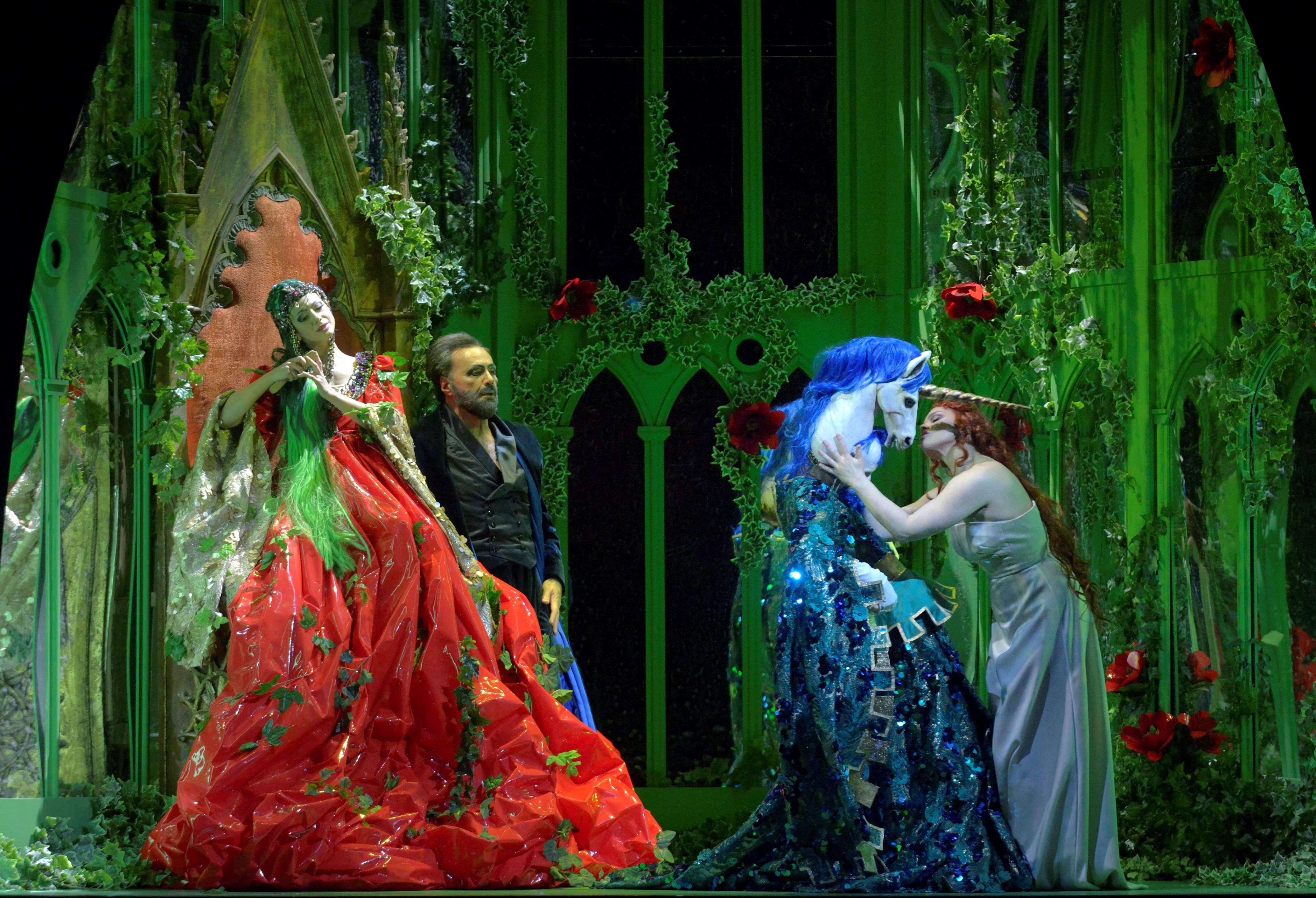|
Back
Dialogues of the Deaf Venezia
Teatro La Fenice
01/17/2020 - & January 19*, 21, 23, 25, 2020
Samuel Barber: A Hand of Bridge, Opus 35
Béla Bartók: A kékszakállú herceg vára, Opus 11, Sz. 48, BB 62
Gidon Saks (David/Bluebeard), Ausrinė Stundytė (Geraldine/Judit), Christopher Lemmings (Bill), Manuela Custer (Sally), Karl-Heinz Macek (The Bard), Pia Mazza, Francesca Penzo, Noemi Bresciani (Bluebeard’s spouses)
Orchestra del Teatro La Fenice, Diego Matheuz (conductor)
Fabio Ceresa (stage director), Massimo Checchetto (sets), Giuseppe Palella (costumes), Fabio Barettin (light designer), Matti Agatiello (choreography)

(© Michele Crosera)
It was astute to pair Bartók’s only opera with Barber’s rarely-performed short opera. Given the stage director’s insight into Bluebeard’s Castle, the musings of the four protagonists in Barber’s A Hand of Bridge are related to the long dialogue that is Bluebeard. Barber’s rarity was first performed at the Spoleto Festival in 1959 as an amusing idea of presenting an opera of minimal duration. Minimal, it certainly is, for it lasts no more than nine minutes!
Given Menotti’s shrewd libretto, much is revealed about the two couples playing bridge. Sally’s only interest is in her frivolous choice in hats, which most likely alludes to the emptiness in her life. Her husband, Bill the lawyer, who fantasizes about his secret lover, infantilized as Cymbaline. Despite his secret pleasure, he lives in fear of being found out and suffers from extreme jealousy. Geraldine, the most touching of the four characters, is described as middle-aged, suggesting a marriage of interest by her greedy husband, the stockbroker David. She suffers from being unloved by those around her and regrets not having expressed her love to her now seriously ill mother, the only person who has really loved her. Finally, David the stock market man has fantasies that are more intense than the other three combined. He dreams of being more successful and wealthier. He envies his rich employer. He wants to be rich to have twenty young women and twenty young men tending to his sexual needs. He is unable to conceive of love beyond the purchase of physical pleasure. All this is displayed in a mere nine minutes.
The singers, especially the two women, are fancifully dressed, as are the characters in the four protagonists’s fantasies, from shopkeepers, Geraldine’s mother, Cymbaline and the numerous sexualized young men and women. The music is lighthearted with a feel of Swing, indicating that this game of bridge takes place in the roaring twenties. The entire work revolves around the inability to communicate despite proximity.
For Bluebeard, stage director Fabio Ceresa follows Hungarian conductor István Kertész’s (1929-1973) interpretation of the work: he sees it not as a grand guignol retelling of Charles Perrault’s fairy tale of the fly getting entangled in the spider’s web, but as Judit getting inside Bluebeard’s mind, untangling his mysteries and revealing his secrets, one by one. This Freudian approach is powerful, as it empowers Judit, no more a mere victim enthralled by Bluebeard and ready to give herself to him out of a naive vision of love.
Endowed with a powerful voice, Aušrine Stundytė plays the psychoanalyst to a debilitated Bluebeard. This is reinforced by the baritonal almost fragile quality of Gidon Saks’s bass-baritone and the convincing acting of the South African singer. Despite a ferocious exterior, he looks tired and weak. Had his voice been a deeper bass, this reversal of roles may have been less convincing. Judit opens his secret drawers one by one, starting with the chamber of torture where we see Bluebeard’s alter ego attached to a spider web. Judit disentangles him and upon kissing him, the alter ego collapses. The same is repeated in the armoury where an alter ego is duelling with himself. He is tamed by Judit and collapses upon kissing her. This represents the lack of power of a secret once revealed and understood. The same is repeated in the other chambers: the treasury, the garden, the kingdom and the pool of tears. These chambers symbolize inner secrets or vices. The treasury, with its gold and jewels, symbolizes his greed, while the garden may symbolize a secret sensuality. The alter ego in the latter dances sensually, almost in an effeminate style. As a clin d’śil to Venice, a gondola is shown in the pool of tears driven by a Charon-like figure, symbolizing the souls of Bluebeard’s victims.
Massimo Checchetto’s sets were indeed striking, especially the garden which was almost too sensual with its delicate gothic columns and a moaning beauty in a rich red dress seated on a throne and Bluebeard’s alter ego dressed in a rich green oriental dress. The lighting was effective, especially in the treasury with the blinding gold and glittering jewels. Most impressive was the final chamber which Bluebeard is very reticent to reveal, but when he does one’s hope for a different ending for such a strong Judit is shattered. She discovers his dead wives living in that chamber and she is to become one of his victims. Rather than stressing horror, almost blissful renunciation was expressed, be it through the sensuality of Stundytė’s voice and movements or through conductor Diego Matheuz’s sensuous slow tempi. Utterly striking was this final image of the now four richly clad wives, met by Bluebeard at dawn, at noon, at dusk and at night, with four versions of Bluebeard representing his various stages of life. One almost felt sorry for the declining old Bluebeard reaching the end of his life. The symbolism may have different meanings, including either the serial wife killer’s demise or his dubious redemption.
Ossama el Naggar
|